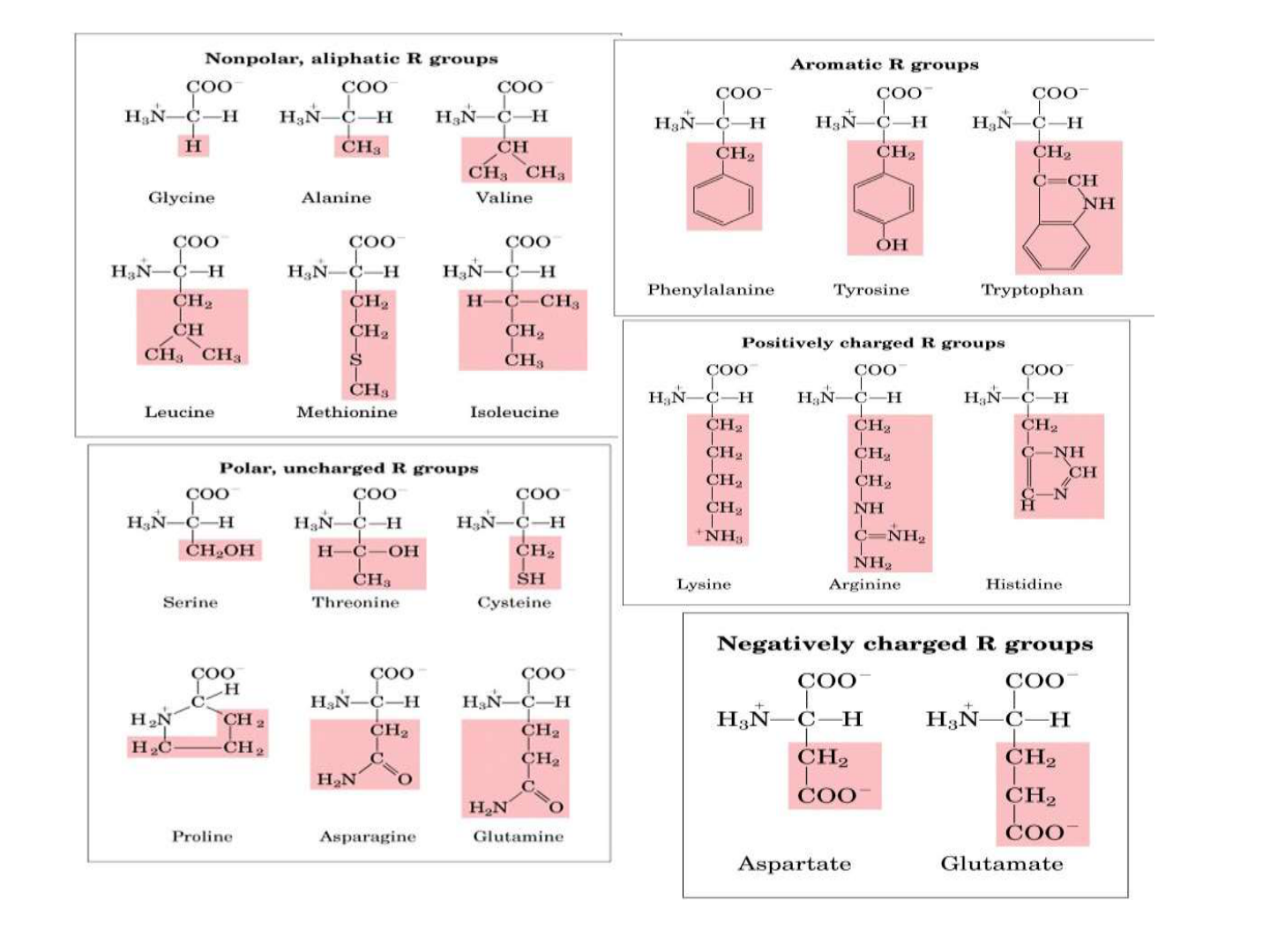
AMINO ACIDS
CLASSIFICATION
AND
PROPERTIES

Amino acids are organic compounds containing
amine [- NH
2
]
carboxyl [-COOH]
side chain [R group]
The major key elements if amino acids are carbon,
hydrogen, nitrogen, oxygen.
About 500 amino acids are known (though only 20
appear in the genetic code) and can be classified in
many ways
WHAT ARE AMINO ACIDS.

BASIC STRUCTURE[SKELETON]


Classification of amino acids gives the grouping
between 20 acids and a basic outline for grouping.
It makes a clear idea to pick the amino acid type
This is much useful for biochemists for the easy
understanding between each amino acids.
NEED FOR CLASSIFICATION

Classification:
Based on
R group
Polarity and R group
Distribution in protein
Nutritional requirements
Number of amino and carboxylic groups

Based on R-Group
• Simple amino acids:
these have no functional group in their side
chain.
Example: glycine, valine, alanine, leucine,
isoleucine
• Hydroxy amino acids:
these have a hydroxyl group in their side
chain
Eg: serine, threonine

• Sulfur containing amino acids:
have sulfur in their side chain
Eg: cysteine, methionine
• Aromatic amino acids:
have benzene ring in their side chain
Eg: phenylalanine, tyrosine
• Heterocyclic amino acids:
having a side chain ring which possess at
least on atom other than carbon
Eg: Tryptophan, histidine, proline

• Amine group containing amino acids:
derivatives of amino acids in which
one of carboxyl group has been transformed
into an amide group
Eg: Asparagine, glutamine
• Branched chain amino acids:
A branched-chain amino acid (BCAA) is
an amino acid having aliphatic side-chains with
a branch
Eg: leucine, isoleucine, valine

• Acidic amino acids:
have carboxyl group in their side chain
Eg: Aspartic and Glutamic acid
• Basic amino acids:
contain amino group in their side chain
Eg: Lysine, Arginine
• Imino acid:
Amino acids containing a secondary amine
group
Eg: Proline

Polarity and R Group
• Amino acids with non polar R group:
these are hydrocarbons in nature,
hydrophobic, have aliphatic and aromatic groups
[aliphatic R groups]
Eg: Alanine, Valine, Leucine, Isoleucine, Proline.
[Aromatic groups]
Eg: Phenylalanine, Tryptophan,
Methionine(sulfur)

• Amino acids with polar but uncharged R
Group:
these amino acids are polar and possess
neutral pH value.
Eg: Glycine, Serine, Threonine, Cysteine,
Tyrosine, Glutamine, Asparagine.

• Negatively charged amino acids:
their side chain [R Group] contain extra
carboxyl group with a dissociable proton.
And renders electrochemical behaviour to
proteins
Eg: Aspartic acid and Glutamic acid
Aspartic acid

• Positively charged amino acid:
their side chain have extra amino group
Rendering basic nature to protein,
Eg: Lysine, Arginine, Histidine.
Lysine

Distribution in protein:
• Standard protein amino acids:
the amino acids that are used to form
proteins,
recognized by ribozyme autoaminoacylation
systems
Eg:
Histidine, isoleucine, leucine, lysine, methionine,
phenylalanine, threonine, tryptophan,
and valine

• Non standard protein amino acids:
these amino acids are not required to build
proteins.
have a vital role as metabolic intermediates.
Eg. Hydroxyproline, Hydroxylysine,
Carboxyglutamate, Diaminopimelate.

• Non standard non protein amino acid:
These are the derivative of amino acids and
have role in metabolism.
Eg: Alpha amino butyrate, Citruline, Ornithine,
beta-alanine.

Based on nutritional requirements:
• Essential amino acids:
Essential amino acids cannot be made by the
body.
As a result, they must come from food.
The essential amino acids are: Arginine,
histidine, isoleucine, leucine, lysine, methionine,
phenylalanine, threonine, tryptophan, and
valine.

• Non essential amino acids:
An amino acid that can be made by humans and
so is essential to the human diet.
The nonessential amino acids: Alanine,
asparagine, aspartic acid, cysteine,
glutamic acid, glutamine, glycine, proline,
serine, and tyrosine.


On basis of number of amino and carboxylic
groups:
Monoamino- monocarboxylic amino
acids
• glycine, alanine
• proline
• phenylalanine
• methionine
• serine, threonine

• Monoamino-dicarboxyli amino acid:
Aspartic and glutamic acid

• Diamino-monocarboxylic amino acids:
Lysine, arginine, histidine.

Properties : Physical
• Colourless
• Crystalline in nature
• Tasteless[tyrosine], sweet[glycine, alanine]
• Melting point above 200•C
• Soluble in polar solvent and Insoluble in non
polar solvent
• Have absorbance at 280nm

• Mol wt: 100 – 50,000Dt
• All amino acids possess optical isomers due to
the presence of asymmetric α-carbon atoms.
• Some are structurally stable and sterically
hindered [Glycine]
• Amino acids [proteins]posses enzymatic
activities
• Amino acids exhibit colloidal nature and
denaturing property

Chemical properties
• Decarboxylation:
The amino acids will undergo decarboxylation
to form the corresponding “amines”. Thus
amines are produced
• Histidine → Histamine + CO
2
• Tyrosine →Tyramine + CO
2
• Lysine →Cadaverine + CO
2

• Reaction with Ninhydrin:

• Reaction with Alkalies (Salt formation):
• The carboxyl group of amino acids can release a
H
+
ion with the formation of Carboxylate (COO
–
) ions.
• Reaction with Alcohols (Esterification) :
• the amino acids is reacted with alcohol to form,
“Ester”. The esters are volatile in contrast to the form
amino acids.

• Reaction with DANSYl Chloride:
DANSYl chloride means “Dimethyl Amino Naptha
Sulphonyl Chloride”.
When the amino acid reacts with DANSYl chloride
reagent, it gives a “Flourescent DANSYl derivative
• Reaction with acylating agents (Acylation):
When the amino acids react with “Acid chloride” and
acid anhydride in alkaline medium it gives “pthaloyl
amino acid

• Reaction with Sanger’s reagent:
• “1-flouro-2,4-dinitrobenzene” is called
Sanger’s reagent (FDNB).sanger’s reagent
reacts with α-amino acid to produce Yellow
coloured derivative, DNB-amino acid.

• Reaction with Edmann’s reagent:
Edmann’s reagent is “phenylisothiocyanate”. When amino
acids react with Edmann’s reagent
it gives “phenyl thiohydantoic acid” finally it turns into
cyclized form “Phenyl thiohydantoin” (Edmann’s derivative).

• Reference :
Dr. J.L. Jain – Fundamentals of Biochemistry by
Chand publications, New Delhi.
